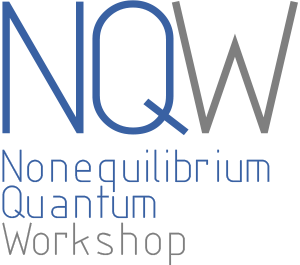Chair: Jaka Vodeb
- Invited talk
Robin Steinigeweg: Constructing nonequilibrium steady states from equilibrium correlation functions
State-of-the-art approaches to extract transport coefficients of many-body quantum systems broadly fall into two categories: (i) they target the linear-response regime in terms of equilibrium correlation functions of the closed system; or (ii) they consider an open-system situation typically modeled by a Lindblad equation, where a nonequilibrium steady state emerges from driving the system at its boundaries. While quantitative agreement between (i) and (ii) has been found for selected model a...
- Invited talk
Rok Zitko: Richardson model description of spin-orbit coupling in superconducting islands
Richardson model, first introduced in nuclear physics as a simplified model of nucleon pairing, is also an appropriate description of a small superconducting island with fixed charge. Complex systems composed of interconnected superconducting islands and interacting quantum dots can be modelled using Hamiltonians that can be transformed into the matrix-product-operator form with small matrices that can be efficiently solved using the density matrix renormalization group. This approach allows ...
- Invited talk
Simon Gerber: Direct characterization of photo- and electrically-induced “hidden” state switching of 1T-TaS2
Brilliant, ultrashort, and coherent X-ray free-electron laser (FEL) pulses allow for investigation of dynamics at the inherent time and length scale of atoms. I will illustrate this capability at the example of recent time-resolved X-ray diffraction data taken in the “hidden” phase of the Van der Waals material 1T-TaS2, hinting that out-of-plane restacking suppresses the optically-induced hidden state. Furthermore, I will also present preliminary static micro-beam X-ray diffraction data o...
- Contributed talk
Corinna Burri: Spatial mapping of the electronic structure of 1T-TaS2
As a step towards resolving the spatially-resolved electronic structure of the layered transition metal dichalcogenide 1T-TaS2 – and eventually electronically switched cryomemory devices – we have performed angle-resolved photoemission spectroscopy (ARPES). Using a photon energy of 72 eV and the micrometer spot size available at the spectromicroscopy beamline of the Elettra synchrotron, we measured the band structure and high-statistics Fermi surface of 11, 500 and 600 nm thick flakes. Al...
Dinner
Chair: Tomaz Mertelj
- Invited talk
Patrycja Łydżba: Integrals of motion in dipole-conserving models
The Hilbert space fragmentation, for which the Hamiltonian shatters into exponentially many blocks in the site occupation basis, can result in the breakdown of thermalization. In this presentation, we focus on the pair-hopping (PH) model, a paradigmatic model of the Hilbert-space fragmentation. Furthermore, it can be derived as an effective model of the Stark chain, imposing strict conservation of the dipole moment. Notably, the non-vanishing autocorrelation functions in the PH model, as repo...
- Contributed talk
Miroslav Hopjan: Critical quantum dynamics of observables at eigenstate transitions
It is an outstanding goal to unveil the fingerprints of universal quantum dynamics at eigenstate transitions. Focusing on quadratic fermionic Hamiltonians, we identify physical observables that exhibit critical behavior at the transition. Our result is based on two ingredients: (a) A relationship between the observable time evolution in a many-body state and the transition probabilities in single-particle states, and (b) a scale invariance of transition probabilities, which generalizes the re...
- Contributed talk
Hui Zhao: Laser-induced tunnel ionization and femtosecond nonthermal melting in MgO
Laser-induced melting plays a crucial role in advancing manufacturing technology and ultrafast science; however, its atomic processes and microscopic mechanisms remain elusive due to complex interplays between many degrees of freedom within a timescale of ~100 femtoseconds. We employ MgO as an example to investigate the nonequilibrium mechanisms of laser-driven ultrafast nonthermal melting of wide-gap materials. Our study is based on real-time time-dependent density functional theory (rt-TDDF...
- Contributed talk
Rok Venturini: Nanoscale polytype heterostructures
The transitional metal dichalcogenides crystalize in different polytypes, dictating their charge density wave (CDW) states. It is possible to perform the polytype transformation in situ by either an optical or an electrical pulse, creating new nanoscale structures and polytypes that sometimes do not exist as bulk materials. We explore the polytype transformed structures of bulk materials 2H-NbSe2 and 4Hb-TaSe2.Using the electrical pulse from the STM tip, the surface of the 2H-NbSe2 is transfo...
- Contributed talk
Yevhenii Vaskivskyi: Electronic Amorphous State of 1T-TaS2: An Order Embedded in the Disorder
The 1T-TaS2, a peculiar transition metal dichalcogenide with a charge density wave (CDW) at low temperatures, has been studied for the last 10 years since the original discovery of a metastable hidden (H) state in it. Mainly, the research was focused on the properties of this state as well as their possible applications. The H-state can be achieved by driving the material out of equilibrium using an ultrashort laser pulse or a short electrical pulse. Similarly to the H-state, at higher excita...


